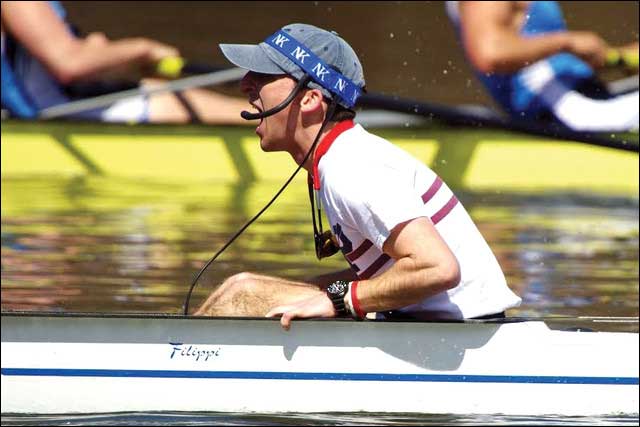The term crew is used in American schools and colleges to designate the sport of rowing. When outside of the academic sphere then the sport is known as rowing, as in the United States Rowing Association or Philadelphia Girl’s Rowing Club. The British and European universities and schools have rowing clubs and not crew clubs or varsity crew.
Athletes with only one oar are sweep rowers. Those with two oars are scullers. Sweep boats may or may not carry a coxswain (pronounced cox-n) to steer and be the on-the-water coach. In boats without coxswains, one of the rowers steers by moving the rudder with his or her foot. Sweep rowing is found in different designations as identified below.
It is perfectly correct to call the boat a boat. Another term that is used is shell. Either term is commonly used.
Rowing Boats – One Oar Per Rower
Coxless-pair: Two rowers with no coxswain
Coxed-pair: Two rowers with a coxswain
Coxless-four: Four rowers with no coxswain
Coxed-four: Four rowers with a coxswain
Eight: Eight rowers with a coxswain
Athletes with two oars–one in each hand—are scullers. As shown below, there are multiple sculling designations. The most common are 1x-, 2x- and 4x-. Sculling offers the unique flexibility of being in a boat with other people or alone.
Sculling Boats – Two Oars Per Rower
Single-scull or Single: One person sculling (with pair of sculls)
Double-scull or Double: Two people sculling
Quadruple-scull or Quad wo/cox: Four people sculling
Quadruple-scull or Quad w/cox: Four people sculling with a coxswain
Most schools and colleges have a match racing season (spring). This is when two or three schools agree to race side-by-side on a straight, or as straight as possible, course that can fit on the local lake, river, or bay. The boats line up abreast standing still and a referee/starter, when satisfied that the crews are level and ready to start, will give the commands Attention… Go. The boats start from a standing stop and race in a lane either imaginary or marked by buoys for a set distance. The first boat to reach the finish line is the winner.
The international (Olympic) distance is 2000 meters (1.25 miles). High schools may race 1500 meters and masters typically row 1000 meters. The Harvard-Yale boat race begun in 1852 is 4 miles and the Oxford-Cambridge boat race begun in 1829 is 4.25 miles.
A Championship Regatta usually will have a maximum of about six boats in a race at a time. Since Championship Regatta may have more than six entries, a system of selecting the faster crews is used. There will be qualifying heats to begin to sort the crews out. One format is the first or first few crews go directly to the grand final (1–6 places), the next or next few crews go to the petite (small) final (7–12 places). In another more final format, there will be repechage races to give the non-qualifying crews from the heats a second chance to qualify for the Grand and Petite Finals.
In the fall season there are head races. The name comes from the traditional English race called the Head of the River. The first head race was the Head of the Charles Regatta in Cambridge/Boston begun in 1965. Now there are many. These are usually open regattas with many events defined in any way the regatta committee wishes to. A junior in one regatta could be anyone under 19 years old, in another it could be defined as high school.
The distance can vary, but usually in the 3-mile range. Sometimes the race course is over a winding river like the Charles. The race is a timed event with each crew starting in a single file and negotiating the race course as fast as possible. The start time and finish times are recorded and the elapsed time is calculated. The fastest time wins. Sometimes in masters events there is an age adjusted handicap. Crews passing each other is usually exciting, particularly on a narrow river or a tight bend. Crews don’t really know how they placed until a printout of the times are posted.
The coxswain is the person that steers the boat. He/she is called a coxswain or cox’n or cox and he/she is coxing a boat. These days, a cox’n usually uses an electronic amplifier system. It not only amplifies the cox’n’s voice through a speaker system, but it has a built-in stroke rate meter and a timer. He/she should be very light so that the crew doesn’t have to carry extra weight on the race course.





